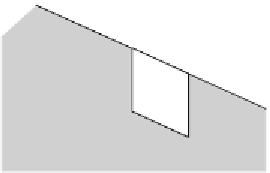Geoscience Reference
In-Depth Information
compatibility conditions, will be in between the lower and upper limit (Drucker's
postulate). However, for frictional materials, such as soils, this statement may not
be valid. Nevertheless, in practice, it is commonly used for evaluating soil stability.
One may apply a lower-limit solution (finite element simulation) or an upper-limit
solution (slip-line approach) and adopt appropriate safety factors. Well-studied
examples of the limit analysis approach are the stability of (infinite) slopes, vertical
excavation (Rankine's solution), and the ultimate bearing of shallow foundations
(Prandtl's solution and Brinch Hansen's method).
B
SLIDE ON LONG SLOPES
(
MICRO
-
STABILITY
)
Slope stability can be analyzed by assuming it to be a section of a long slope,
which is expected to locally slide along a slip plane parallel to its surface. Let the
soil be undrained and the shear strength expressed by |
| < c
u
. Critical equilibrium
of forces (see Fig 10.1a), i.e. the resistance force
R = b
s
, where
b
is the width of
the section, can just counteract the tangential force
T = W
sin
)
, related to weight
W
= Hb
cos
)
and slope angle
)
, thus
R = T
gives at depth
H
of the slip surface,
where
s
= c
u
T = c
u
b = R = W
sin
)
= Hb
cos
)
sin
)
(10.1)
<
45
o
, and the depth at which the slip supposedly
It applies for slopes 0
<
)
occurs is
H = c
u
/(
sin
)
cos
)
)
(10.2a)
The corresponding stability factor is expressed by
1
c
F =
(10.2b)
(
u
)
sin
)
cos
)
H
under which a soil
layer of thickness
H
is just stable. A thinner layer will be stable at a steeper slope,
provided (10.2b) holds for
F
>
1
.
Formula (10.2b) indicates for
F = 1
a slope at the angle
)
DC
DC
DC
1
1
1
b
b
b
c
c
c
H
H
H
H
E
1
E
1
E
1
T
T
T
O
O
O
W
W
W
s
s
s
)
)
)
)
)
)
)
N
N
N
E
2
E
2
E
2
s
s
s
s
s
s
s
s
s
T
s
T
s
T
s
(a) (b)
Figure 10.1



















































































































































































Search WWH ::

Custom Search